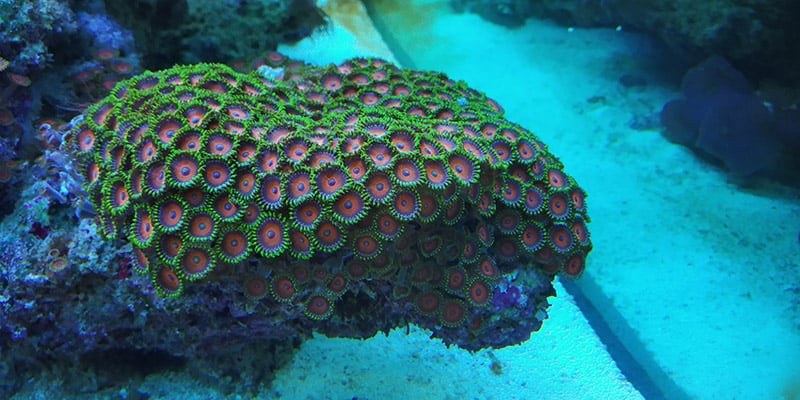Zoanthids are a choice beginner’s coral. They are extremely hardy, durable, and can be incredibly colorful as well!
Zoanthids are generally a very undemanding coral. Zoas are some of the hardiest and most durable inhabitants for the reef aquarium. They are easy to keep and make a wonderful beginner’s coral. Take good care of them and you’ll be rewarded with a beautiful display!
Zoanthids are commonly referred to as Button Polyps, Colonial Anemones, or Sea Mats. They resemble clusters of miniature sea anemones, often growing like a mat across a hard substrate. But although they may look similar in appearance to anemones, they are much smaller, with their oral discs barely reaching 1 – 2 cm in diameter.
Zoanthids are very attractive colonial anemones. They can make a colorful addition to the hard surfaces of the reef aquarium. They come in all sorts of colors from browns and grays to bright orange, red, yellow, green, blue and many color morphs. Yet the coloration seen on Zoanthids is usually not a product of their own pigments. Rather it comes from a marine algae, zooxanthellae, that live within their tissue. As this algae needs light to thrive, so do the colorful Zoanthids!
To learn more about Zoanthids see:
The Fabulous Zoanthids: Button Polyps, Colonial Anemones, Sea Mats, and Stick Polyps
Easy to Keep Zoanthids
In nature zoanthids are often found in turbid, high-nitrate areas in canals, harbors, inter tidal areas and reefs. For this reason they are fairly tolerant of poor water quality or high nitrates, phosphates, and dissolved organics.
It is easy to keep most of the species of Zoanthids found in the aquarium industry. Yet there are some species that live in conjunction with sponges or other invertebrates. At one time these Zoanthids were thought to be parasitic, but now it is believed that they actually work in a mutualistic relationship, each benefiting from the arrangement. Keeping these specialized species is more difficult as you must keep their companion alive as well.
A normal reef environment is needed to keep most colonial anemones. Zoanthid care includes proper lighting, good water movement, and regularly feeding. Also provide hard surfaces for these sea mats to encrust such as live rock, regular rock, dead corals, or pieces of porous ceramic. They will not do well if filamentous algae is allowed to grow in the reef aquarium, as they can be smothered by it.
Zoanthid Care
Like most sessile organisms, these Button Polyps need good water flow to bring food and help rid them of waste. Many species live symbiotically with the marine algae, Zooxanthellae, which need light to thrive. The species that contain zooxanthellae require a strong lighting source. Those that do not contain zooxanthellae don’t require the strong lighting but will not be adversely affected by it.
Tank Mates for Zoanthids
In a well-established aquarium, Zoanthids can be kept with fish and a number of other invertebrates. But they will compete for space they just like other colonial and sessile encrusting invertebrates. They don’t have a very strong sting, so are at a disadvantage there, but they are fast growers, so can often overtake their neighbors. When it comes to placing zoanthids next to Corallimorphs, (mushroom anemones), the zoanthids almost always lose. Always place these kinds of corals a good distance away from each other.
There are several fish species that will dine on zoanthids. These fish include the Raccoon Butterflyfish, Chaetodon lunula, which have been used recently to eat aiptasia, many filefish (Monacanthidae), and Sharpnosed Puffers (Tetraodontidae).
Featured Image Credit: Sandeep Gawade, Shutterstock









